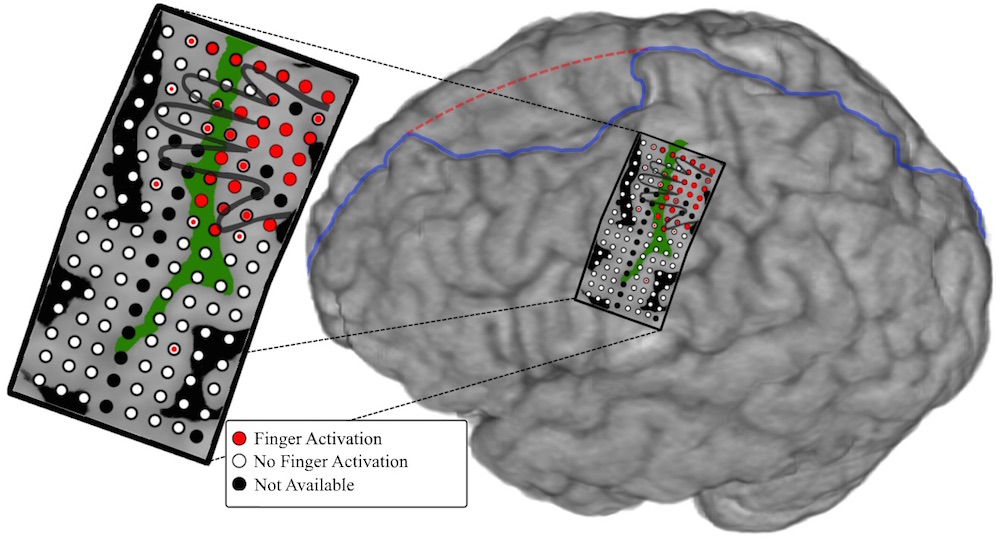Whoa! Mind-Controlled Arm Lets Man Move Prosthetic Fingers

A new mind-controlled prosthetic arm was used to help a patient wiggle the device's fingers simply by thinking about it, and required very little training on the patient's part, according to a new study.
The research, though still in its nascent stages, could potentially help people who have lost arms due to injury or disease regain some mobility, the researchers said.
"We believe this is the first time a person using a mind-controlled prosthesis has immediately performed individual digit movements without extensive training," study senior author Dr. Nathan Crone, a professor of neurology at the Johns Hopkins University School of Medicine, said in a statement. "This technology goes beyond available prostheses, in which the artificial digits, or fingers, moved as a single unit to make a grabbing motion, like one used to grip a tennis ball." [Body Beautiful: The 5 Strangest Prosthetic Limbs]
However, the man in the experiment was not missing an arm or a hand. He was at the hospital for epilepsy treatment, and was already scheduled to undergo brain mapping so that doctors could determine where the seizures started in his brain, the researchers said.
Doctors surgically implanted electrodes into the man's brain to track his seizures. But they also mapped and found the specific areas of his brain that move each finger, from the thumb to the pinkie.
That was no easy feat. A neurosurgeon carefully placed an array of 128 electrode sensors — all on a rectangular film the size of a business card — on the region of the man's brain that controls hand and arm movements. Each sensor covered a small, circular spot on the brain that measured 0.04 inches (1 millimeter) in diameter.
After the implantation, researchers asked the man to wiggle different fingers. The team noted which parts of his brain "lit up" when the sensors detected neural electrical activity from each finger movement.
Get the world’s most fascinating discoveries delivered straight to your inbox.
The team also noted which parts of the brain were involved in feeling touch. They gave the man a glove that vibrated at the tip of each finger. Again, the researchers identified the different areas of the brain that "lit up" when the man felt the vibrations on his fingers.
After collecting the motor (movement) and sensory data, the researchers programmed the prosthetic arm, which was developed at the Johns Hopkins University Applied Physics Laboratory. Whenever a certain part of the man's brain expressed electrical activity, the prosthetic would move a corresponding finger.
This turned the electrode sensors into the ultimate mind-reading machine. Researchers connected the electrodes to the prosthesis, and asked the man to think about moving his fingers one at a time. Within moments of when the man moved his real fingers, the fingers on the prosthetic arm moved, too.
"The electrodes used to measure brain activity in this study gave us better resolution of a large region of cortex than anything we've used before and allowed for more precise spatial mapping in the brain," said Guy Hotson, a graduate student and lead author of the study. "This precision is what allowed us to separate the control of individual fingers." [Bionic Humans: Top 10 Technologies]
Handy accuracy
At first, the mind-controlled arm was accurate just 76 percent of the time. But then, researchers coupled the ring and pinkie fingers together, which increased the accuracy to 88 percent, they said.
"The part of the brain that controls the pinkie and ring fingers overlaps, and most people move the two fingers together," Crone said. "It makes sense that coupling these two fingers improved the accuracy."
Moreover, the device is easy to use, and doesn't require extensive training, the researchers said.
Yet, the technology is still years away from clinical use, and it will likely be expensive, the researchers said. But it would undoubtedly help many people. There are more than 100,000 people living in the United States with amputated hands or arms, according to the Amputee Coalition of America, a Virginia-based nonprofit organization that represents people who have experienced limb loss or amputation.
There are already myriad technologies designed to help people with missing limbs. For instance, advances in prosthetic limbs and artificial skin are helping to restore a sense of touch for people, even if they've lost extremities.
The new study was published online Feb. 10 in the Journal of Neural Engineering.
Follow Laura Geggel on Twitter @LauraGeggel. Follow Live Science @livescience, Facebook & Google+. Original article on Live Science.

Laura is the managing editor at Live Science. She also runs the archaeology section and the Life's Little Mysteries series. Her work has appeared in The New York Times, Scholastic, Popular Science and Spectrum, a site on autism research. She has won multiple awards from the Society of Professional Journalists and the Washington Newspaper Publishers Association for her reporting at a weekly newspaper near Seattle. Laura holds a bachelor's degree in English literature and psychology from Washington University in St. Louis and a master's degree in science writing from NYU.


